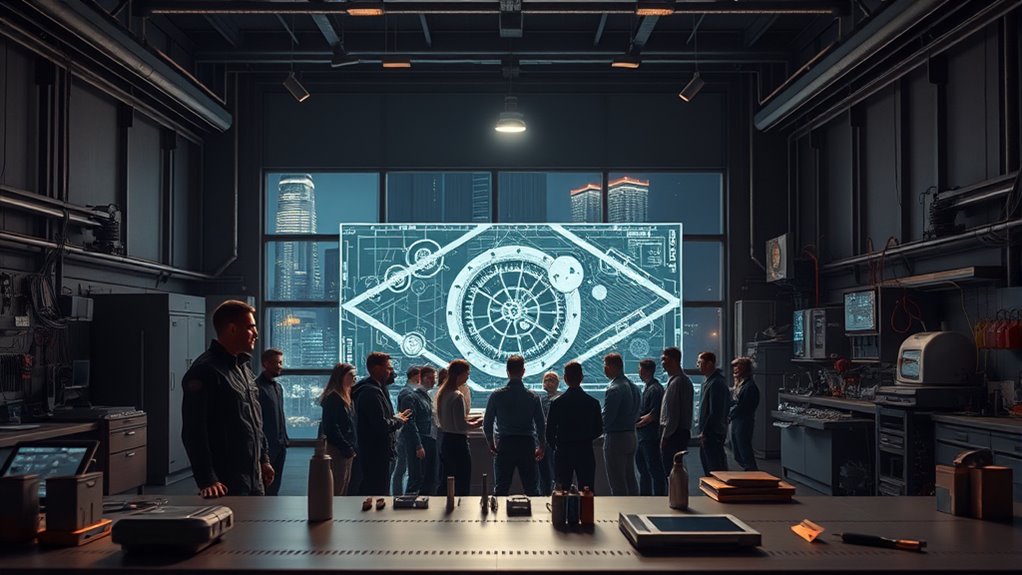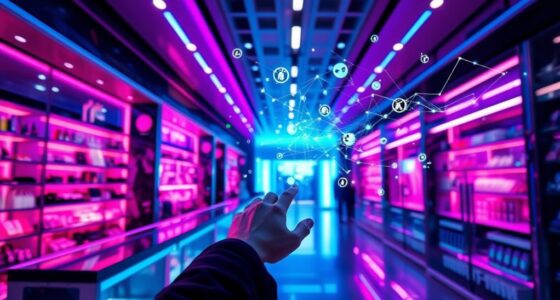To craft the first human systems framework after AI dominance, focus on integrating human-centered design with holistic, adaptive approaches. Prioritize understanding human needs, strengths, and values across social, cognitive, and physical domains. Balance technical innovations with safety, skills, and organizational culture, ensuring systems support resilience, flexibility, and collaboration. By aligning AI and human roles thoughtfully, you’ll build networks that respect human uniqueness. Exploring these key concepts further will help you shape a future where humans remain central in complex systems.
Key Takeaways
- Prioritize human-centered design to ensure systems support human cognition, physical needs, and psychosocial well-being amidst AI proliferation.
- Develop interdisciplinary frameworks integrating human factors, organizational culture, and technical elements for resilient human-AI collaboration.
- Emphasize adaptive, holistic approaches that consider evolving systemic flows, unspoken rules, and layered relationships within human systems.
- Incorporate lifecycle planning—design, deployment, and disposal—to align AI integration with human performance and safety standards.
- Foster continuous feedback and learning mechanisms to evolve human systems, maintaining resilience and effectiveness post-AI dominance.

Understanding human systems is essential for designing effective, resilient networks that shape daily life. These systems are intricate, adaptive networks composed of social, economic, institutional, and cognitive relationships. As you navigate these interconnected webs, you’ll see how individual actions ripple outward, influencing families, communities, workplaces, and entire cultures. These invisible architectures operate through unspoken rules and systemic flows—like traffic patterns or supply chains—that subtly guide daily interactions. Recognizing that human systems are layered, interdependent, and constantly evolving helps you appreciate their complexity. They’re not isolated entities but dynamic, adaptive networks that require careful management to thrive. Understanding human systems is a foundational element in systems thinking, enabling better integration and resilience in complex environments. In the context of human systems integration (HSI), you’re working with an interdisciplinary approach that combines managerial and technical strategies. HSI aims to *maximize* system performance by balancing human, organizational, and technical elements throughout a system’s lifecycle. When designing or improving a network, you consider factors such as manpower, personnel skills, training, safety, and human factors engineering. This ensures that systems aren’t just technologically sound but also aligned with human capabilities and needs. You’ll see that HSI involves early-stage planning, design, development, and even disposal, emphasizing a seamless human-technical harmony. Additionally, applying a holistic perspective helps you address the various layers and interactions within human systems for more effective solutions.
Human systems are complex, adaptive networks shaping daily life through unseen social, economic, and cognitive connections.
Within the HSI framework, core domains like manpower and personnel are *crucial*. You allocate the right number of people with appropriate skills to operate the system efficiently. Training becomes *essential* to develop and sustain knowledge, while human factors engineering guides the design of interfaces and controls that support human cognition and physical abilities. Safety and occupational health focus on protecting users and ensuring survivability during system operation. By integrating these domains, you’re not just creating systems that work but systems that work well with the humans who use them.
Applying a human factors systems approach means considering physical, cognitive, and psychosocial characteristics of individuals or teams. You evaluate task demands—like complexity and psychological stress—and how tools, environments, and organizational culture influence performance. Whether designing medical devices, AI interfaces, or information systems, you ensure that the physical layout, lighting, noise levels, and team dynamics support *ideal* functioning. Ultimately, your goal is to craft a human-centered framework that aligns AI advancements with human strengths, fostering adaptability and resilience in the post-AI era.
Frequently Asked Questions
How Will Human Rights Evolve Post-Ai Dominance?
Your human rights will evolve to emphasize stronger protections against AI-driven discrimination, privacy breaches, and economic displacement. You’ll see new rights focused on data control, fair employment, and equitable access to resources. You’ll actively participate in shaping ethical standards for AI, ensuring these systems align with human dignity and fairness. Collaboration across disciplines will be essential, empowering you to hold AI accountable and safeguard your fundamental freedoms in this new era.
What Industries Will Be Most Affected by New Human Frameworks?
You’ll find the manufacturing, logistics, and energy industries most affected by new human frameworks. In manufacturing, you’ll need to collaborate with AI-driven systems and robots, changing skill requirements. In logistics, you’ll adapt to AI-managed supply chains and autonomous delivery. Energy sectors require oversight of complex AI models for grid stability. Embracing these frameworks helps you work effectively alongside AI, ensuring safety, efficiency, and ongoing human oversight in these rapidly evolving fields.
How Can Global Cooperation Be Ensured in Framework Development?
You can foster global cooperation by actively participating in multilateral institutions like the G7, G20, and UN initiatives that promote inclusive dialogue. Support capacity-building efforts for developing nations, ensuring everyone’s voice is heard. Advocate for transparent standards and shared ethical principles, encouraging collaboration across sectors. By strengthening these channels and respecting diverse perspectives, you help create a unified, fair framework that guides AI governance worldwide, ensuring collective progress and trust.
What Ethical Considerations Are Prioritized in the New Framework?
You prioritize fairness and bias mitigation to prevent discrimination and promote inclusivity. Transparency and explainability are key for building trust and understanding AI decisions. Respect for privacy and human rights guarantees data is protected and used responsibly. Safety and security focus on minimizing harm and preventing misuse. Overall, you emphasize ethical principles that promote equitable, accountable, and trustworthy AI systems, aligning technological progress with societal values and human dignity.
How Will Education Systems Adapt to Ai-Led Societal Changes?
You’ll see education systems become more personalized and adaptive, using AI to tailor learning to individual needs and cultural contexts. Teachers will leverage AI tools to reduce workload and provide targeted support, while curricula will include AI literacy. Schools must also address privacy and equity concerns by establishing clear policies and monitoring AI’s impact, ensuring all students benefit fairly from technological advances. This prepares learners for an AI-driven society and future career demands.
Conclusion
As you forge this new human framework, remember the resilience of Icarus—striving upward while avoiding the sun’s hubris. Embrace your unique qualities and adapt with humility, knowing that history’s lessons guide your way. Like the phoenix rising from ashes, let innovation and compassion lead you forward. In this delicate dance with AI, you hold the power to shape a future where humanity soars, grounded yet daring, charting a course beyond the limits of what was once thought possible.











